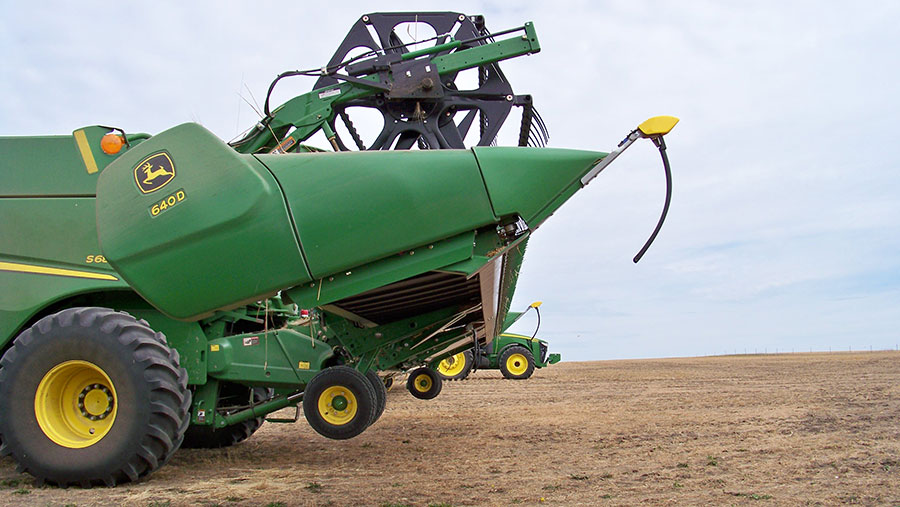Headsight system automates combine header height control

A bespoke header control kit could increase yield and reduce downtime by keeping the table height accurate in all conditions.
The system is built by Canadian firm Headsight, and the patented design provides automated height and tilt control via number of sensors underneath the bed.
These are said to be more accurate and feature better response times than the original header fitments, with farmers in the US, and latterly Europe, now choosing to install an aftermarket system, even on brand-new machines.
See also: Guide to buying a used hill-sider combine
It can be added to most common makes of combine and links into the existing controls on the harvester, so there is little difference to normal driving. There are two controller options for setting it up and making adjustments.
The simpler option is Insight, which is a standalone box mounted outside the cab on the back of the bed, so operators have to stop the machine to tweak the values. It still has advanced settings for the header, and it can cope with up to five sensors feeding back.
The second is the fancier Horizon module, which is operated using an Isobus terminal in the cab and can run through monitors from the likes of Trimble, Ag Leader and John Deere.
This can process information from up to seven height sensors on the header and the control box is capable of automatically calibrating the system while also taking care of the table’s functions.
Included in the Horizon option is Feathersight, which combines the operating range of the header height sensors with the ground pressure experienced by the feeder house lift cylinder. With these two measurements, the operator can run the header through a greater range of positions, from on the deck to 38cm high.
Farmers have apparently found this useful when harvesting undulating and sloping ground, as it can limit the nose-diving as the combine heads downhill. It also feathers the heights changes to keep stubble consistent.

Sensor choices
Similar to other systems on the market, the basic sensor arrangement for Headsight involves a flexible poly arm that uses the spring’s down pressure to get even ground contact across the width.
The flexible poly arm sensor has three different mounting locations. The first location is on a mounting bracket behind the cutterbar, while the second is a slightly lower-profile mount sitting under the cutterbar. This uses existing header guide bolts.
The final mounting option is a narrow profile terrace located in front of the header on the crop dividers. This gives the system the earliest warning of a change in terrain or ground conditions. Headsight recommends this for customers who plan on harvesting at higher speeds in challenging conditions.
Two different length paddles are supplied – shorter ones for the centre of the bed and longer units for the two on the outside. If using the Insight control box, five sensors can be placed along the bottom of the header.
The more technical setup is the Terrahawk radar height sensor that can see through dry material to find the ground. Using radar sensors to detect the surface means no part of the kit runs on the ground, so the risk of wear and potential damage is reduced.
Using the sensors as opposed to the poly arms means the sensors can survey a bigger area, which in turn improves the accuracy of the height range and header stability. However, the Terrahawk sensors are only available with Horizon monitors.
Integration
Headsight has linked up with Shelbourne Reynolds in the States to offer stripper headers that run height control through a custom Horizon app, which is displayed on a touchscreen. It seems an unusual addition to a stripper header, but the company says it is key to maximising straw length and whipping off the ears evenly across the field.
The integrated system means that header settings such as rotor and auger speed can be seen and adjusted, and the operator can be alerted to any change in their rpm.
Header maintenance reminders and hour logs are also recorded, which will be helpful if you change the header independently of the combine.
All this fancy tech can cost anywhere between £3,000 and £6,000, depending on the type and size of header, and a one-year warranty is standard.
